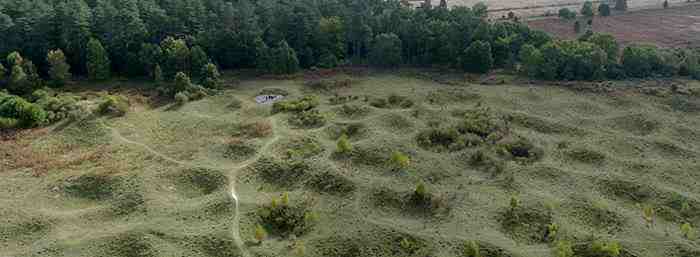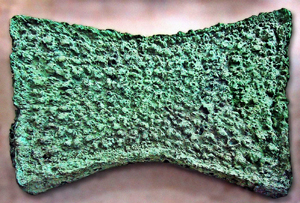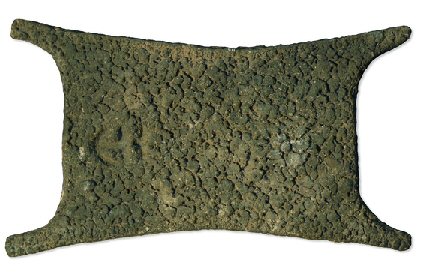The Wilgie Mia red-ochre mine in Australia has been mined for at least 40,000 years, making it the worlds longest continuous mining operation. (9)
Mining in Prehistoric Africa.
Swaziland: At Lion Cave in Swaziland, ancient miners cut a tunnel 25 feet wide, 30 feet deep, and 20 ft high. This tunnel was cut into a cliff face 500 feet tall. This is apparently the oldest known mining operation. The activity has been securely dated to go back at least 43,000 years by carbon 14 and probably goes back even further to 70-110,000 years ago. (Dart and Beaumont, 1971, p. 10; Bednarik, 1992, p. 15; Dart and Beaumont, 1967; Vermeersch and Paulissen, 1989, p. 36). Apparently, the mining was terminated when a 5-ton boulder fell from the roof of the tunnel and blocked the entrance. (Dart and Beaumont, 1967, p. 408) One of the interesting things about Lion cave is that it is a pigment mine. They were mining red ochre, a pigment used by primitive peoples as body paint for their rituals. The amount of material moved is quite impressive. In the literature, estimates of 50-100 tons are regularly quoted.
Dickson, 1990; gives a history of the use of red ochre. He writes:
"Specimens of ochre have been reported from some of the oldest occupation or activity sites known from the Lower Paleolithic period in the Old World, including Bed II at Olduvai Gorge in Tanzania, Ambrona in Spain, Terra Amata in France, and Becov in Czechoslovakia. The use of ochre apparently increases during the Middle Paleolithic period in the Mousterian tradition and becomes common in the Upper Paleolithic period. "Ochre has no apparent practical or technological use until the development of iron metallurgy sometime in the second millennium before Christ when it becomes a principal ore for iron smelting. Nonetheless, many of the Paleolithic period ochre specimens show evidence of having been worked or utilized in some fashion. For example, the two lumps of ochre recovered at Olduvai Gorge show signs of having been struck directly by hammerstone blows (M. Leakey 1971). Howell (1965:129) states that the ochre specimen recovered at Ambrona showed evidence of shaping and trimming, although Butzer (1980:635) asserts this may only be natural cleavage. Still the ochre comes from the same horizon as the famous linear arrangement of elephant tusks and bones and was probably brought to the site by the hominids who are thought to have killed and butchered elephants there. "At Terra Amata, which was occupied around 300,000 B.P., de Lumley (1969:49) reports a number of ochre specimens recovered from the two occupation layers associated with the pole structures uncovered at the site. Specimens of red, yellow, and brown were recovered and the range of color variations suggests the ochre may have been heated. De Lumley also reports that the ends of some of the specimens were worn smooth suggesting they had been used in body painting. "Clearer evidence of ochre use comes from Becov in Czechoslovakia. This cave site, occupied ca.250,000 B. P., yielded a specimen of red ochre that was striated on two faces with marks of abrasion together with a flat rubbing stone with a granular crystalline surface that had been abraded in the center possibly during the preparation of ochre powder (Marshack 1981: 138).
Egypt: Some of the earliest examples of mining for chert (flint) nodules comes from along the Nile valley in Egypt, where numerous examples of mining shafts have been discovered from Palaeolithic times, c. 38 - 33, 000 BC But mining in the Nile Valley goes even further back in time, Vermeersch and Paulissen report on four other sites, Qena and Nazlet Safaha, dating to 50,000 years ago, and Nazlet Khater-2 and Beit Allam, which date to 60,000 years ago (Vermeersch and Paulissen, 1989, p. 36). All of these sites were flint quarries. (6)
Ancient Egyptians mined malachite at Maadi At first, Egyptians used the bright green malachite stones for ornamentations and pottery. Later, between 2613 and 2494 BC, large building projects required expeditions abroad to the area of Wadi Maghara in order "to secure minerals and other resources not available in Egypt itself." Quarries for turquoise and copper were also found at "Wadi Hamamat, Tura, Aswan and various other Nubian sites"on the Sinai Peninsula and at Timna. Mining for precious stones and metals in Egypt occurred in the earliest dynasties. The gold mines of Nubia were among the largest and most extensive of any in Ancient Egypt, and are described by the Greek author Diodorus Siculus. He mentions that fire-setting was one method used to break down the hard rock holding the gold. One of the complexes is shown in one of earliest known maps. They crushed the ore and ground it to a fine powder before washing the powder for the gold dust. (3)
Mining in Prehistoric Europe:
The Neolithic flint mines of Spiennes are Europe's largest and earliest Neolithic mines, located close to Walloon village of Spiennes, southeast of Mons, Belgium. The mines were active during the mid and late Neolithic (4,300-2,200 B.C). (4)
England: The mines at Grimes Graves are especially famous, and like most other flint mines, are Neolithic in origin. They were worked from around 3,000 BC to 1,900 BC with antlers from the red deer. It has been calculated that a medium-depth shafts would have yielded as much as 60 tons of flint nodules, which were brought to the surface and roughly worked into shape on site. It is estimated that 60 tons of flint could have produced as many as 10,000 of the polished stone axes, which were the mines' main product. Extrapolation across the site suggests that Grime's Graves may have produced around 16-18,000 tonnes of flint across the 433 shafts recorded to date. (3)


